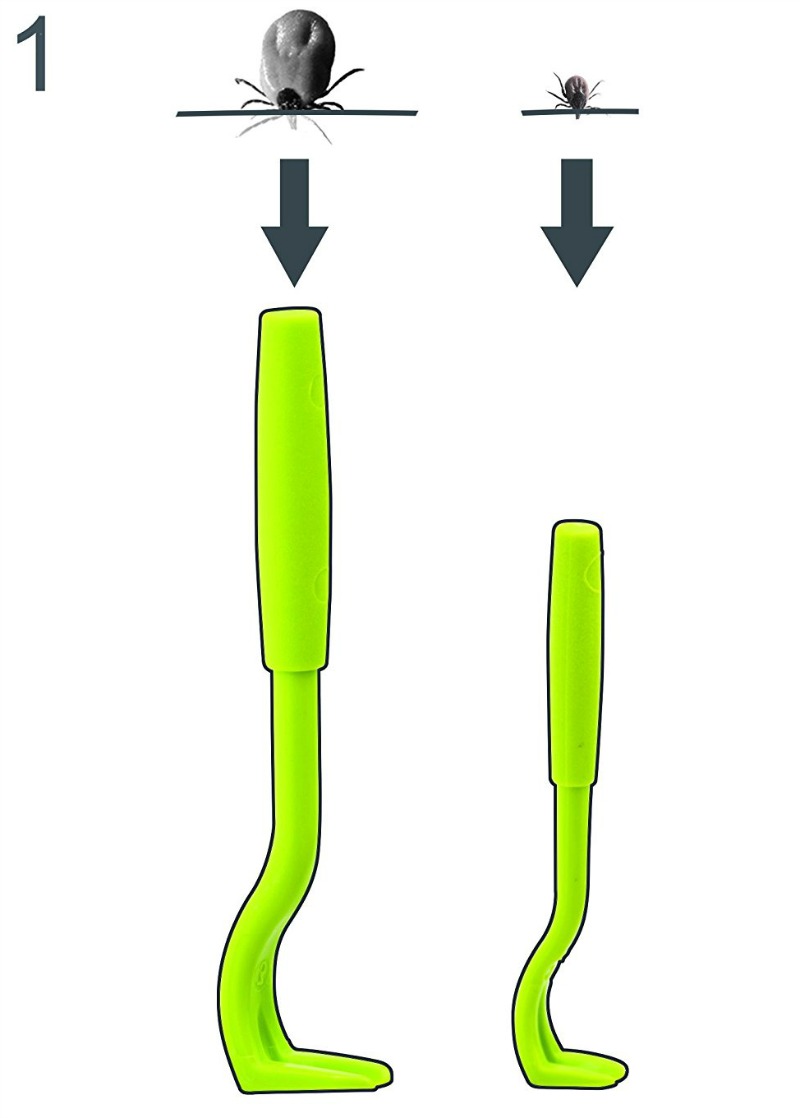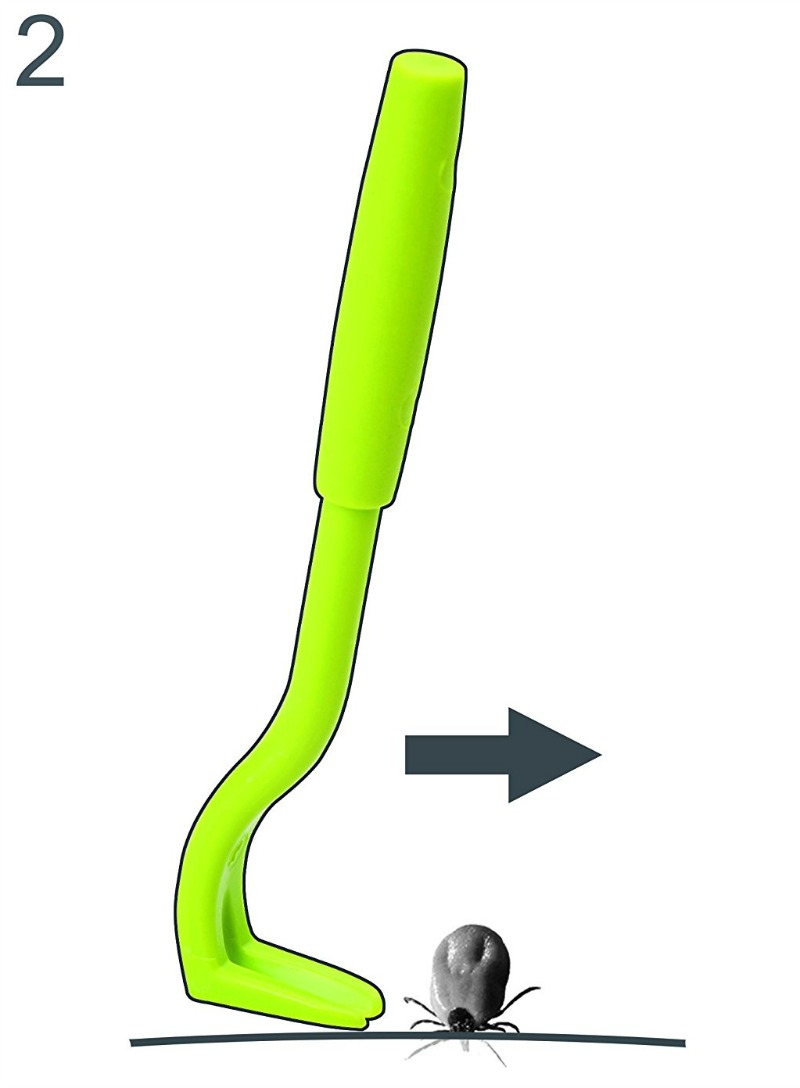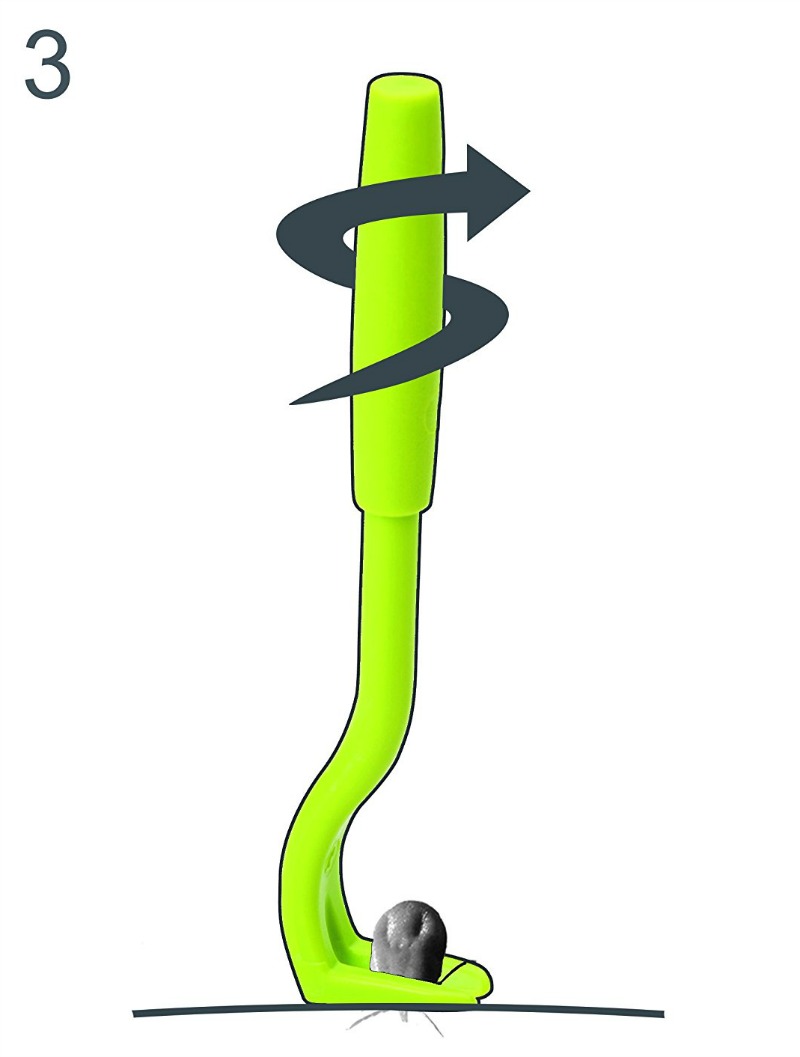Safe method to remove a tick without leaving the head stuck in the skin that works with small or large ticks and is easier than tweezers.

Each spring and summer, warmer weather and spending more time outside and camping outdoors increases the chances of exposure to nasty tick bites. The question is not “if” but “when” it will happen. And, when it inevitably does, how to remove a tick safely to minimize the chances of disease?
I have a friend who lives on a farm in Kentucky with his wife and five children. During tick season, he and his wife perform tick checks every night on all their children right before bathtime. They take ticks very seriously in their home because the Lyme disease carrying kind are very prevalent in their area.
It’s not just Lyme disease that is a potential risk either. The Journal of General Internal Medicine published an article by Susan Wolver, MD, and Diane Sun, MD, which identified a rising trend of red meat allergies from tick bites.
When one of my children was a fairly young baby and not even mobile yet, a tick lodged itself into the top of his head. Most likely, the tick dropped out of a tree onto his head, so don’t think your children are safe just because they aren’t hiking in the woods or walking in the grass!
If you discover that your child or pet has a tick that has lodged itself into the skin, here is the safest, easiest and quickest way to remove it.
How to Remove a Tick Safely and Quickly
The best way to remove ticks is using tweezers according to most authoritative sources. However, there is a new gadget called the tick twister remover that works even better.
My friend in Kentucky says that they used to use tweezers, but the tick twister is far superior and easier to use. It can be used to remove ticks from both pets and people.
Each tick twister tick removal set (it only costs about $6) has two removers inside: one large and one small. The different size is to allow for safe removal of both small and large ticks.
This ingenious device created by a veterinarian to safely remove ticks regardless of a person’s expertise has the following benefits:
- It is easier to use than tweezers especially for small ticks.
- It removes the tick without squeezing it, which greatly reduces the chances of disease transmission.
- It ensures the head and mouthparts of the tick are removed along with the body.
- It can be used for both large and small ticks.
Every home with children and/or pets should have one of these! It should also be included with camping equipment.
Safe Removal Steps. Better than Tweezers!
There are three steps for removing a tick using the tick twister.
First, you select which tick twister to use. If the tick is large, use the larger tick twister. If the tick is small, use the smaller one. Pretty simple!

Second, you grasp the tick between the head and body using the hook end of the tick twister. The picture below shows how to do it.

Third, simply twist the tick twister gently to easily and safely remove the entire tick out of the skin. That’s it!

After removing the tick, thoroughly clean the affected skin with alcohol. If there is any irritation, a dab of this herbal salve does wonders to quickly heal the skin.
Warning About some Tick Removal Recommendations
Some sources recommend pulling a tick straight out of the skin as the best method of removal.
This is very dangerous advice, because trying to pull a tick straight out will almost ALWAYS result in the head staying stuck in the skin. This is because ticks frequently lodge into the skin at an angle. They don’t usually burrow straight in perpendicular to the skin’s surface.
If you must use tweezers because you don’t have the tick twister remover available, be sure to pull the tick out at the same angle it went in.
This will give you the best shot at removing the head along with the body. In other words, grab the tick very firmly and close to the head as you can and pull out on a straight line but the same angle it burrowed in. I hope this makes sense.
It’s a little difficult to describe in words. This is the method taught to me by my Dad, who is a retired family doctor. Using this method, I’ve never left a tick’s head in the skin of any pet or person in over 40 years.
Of course, using the inexpensive tick twister is the best method of all. You don’t have to worry about angles – you simply twist the tick out of the skin!
How to Repel Ticks
This article describes the method for preparing an herbal yarrow tincture which is very effective at repelling ticks so you don’t have to remove them in the first place.
You ideally need to spray yourself every 2 hours or so.
Note that yarrow has been reputedly found by the US Army to be as effective as DEET in repelling ticks.








Fantastic information Sarah!
We have ticks in Australia called “paralysis ticks” that can be deadly to cats and dogs and cause some unpleasant symptoms in people too, so their effective removal is vital. Thanks for sharing this pain-free method that I am sure I could even use on my very squirmy poodle if need be 🙂
Eliza
Eliza, see Judith’s comments above. I think it can be dangerous to remove a tick by making it back out on it’s own. There plenty of info about it in the comments on this blog from people who have removed hundreds of ticks and some who have experience with tick diseases.
This is NOT fantastic information, it is all incorrect. Read the earlier comments.
Eliza, don’t do this. It’s false, dangerous information. Do the research yourself from sources that actually know. Most of what’s in this post came from an anonymous email that’s been circulating for years.
Thanks for the clarification, all of you!
Here in Australia, paralysis ticks are a real problem and I would not want to do anything that would cause the tick to deposit more poison into the system as it can be deadly for animals… I always have used a ‘tick stick’ in the past to pull the tick straight out, but the soap approach appealed to me as being possibly pain-free for my wussy dog. He’s just going to have to toughen up though 😉
Love x
This post about ticks and Lyme disease is freaking me out! My kids and I LOVE to be outside! Should we now stay indoors and away from the woods (which is fun for geocaching!) now to avoid Lymey ticks? Which website can I go to to find out which parts of the US are tick-prone? (Disease-carrying kind). What about Florida? Pacific Northwest?
Thanks!
You could start by checking out the links I posted, especially the Tickencounter link. Also, go here: http://saluqi.home.netcom.com/ticklinks.htm and look there for sites. Most state universities have information about the local tick situation, though some are better than others. Don’t think only in terms of Lyme. Think in terms of all the tick-borne diseases. More info on them at the links. The saluqi links are mostly about dogs, but there are also some about humans, and ticks in general. They should give you a good background.
But the best thing is to use appropriate repellant, stay out of brush and high grass if possible, and do a complete tick check every 12 hours, or at least every 24 hours, including every inch of your body. If you remove a tick early, it can’t transmit disease. learn how to remove a tick (I posted good links on this) and have the right tool with you when you are outside. And don’t do what this original post was about–don’t put anything on the tick to make it detach itself. That makes it much more likely to transmit disease. Remove it yourself, properly. Then you are safe.
Thanks Judith. What’s an appropriate repellant? DEET? What’s a safe yet effective alternative for kids?
I know that Judith has reason to be more cautious about this, but unless you live in areas that are prone to certain diseases the chances of you catching anything are pretty slim. If you’ve been playing out in the woods, do a tick check at bath time or when you get home and remove any the way Judith outlined above. DO NOT FEAR THE OUTDOORS!!!
Actually, we all have reason to be cautious about this. There have been cases of Lyme reported in all 50 states. It is true that some of these cases may have been travel-related, but, having known several folks who have suffered and been forever changed/disabled by Lyme Disease and coinfections, I refuse to delude myself into believing that a tick in a non-Lyme endemic area is not of concern. Disease-ridden ticks can travel just like people—especially since they hitch rides on people and animals.
If you have smoke detectors in your home, or wear a seatbelt when you ride in a car, then you probably will want to take precautions against ticks–wherever you live. Lyme is not the only devastating illness you can get from a tick.
Nicole is right. Evey state in the US, and parts of Canada, have at least one tick-borne disease. And they are spreading, because of global warming. A friend in Anchorage told me they didn’t use to have ticks, but they do now. Ticks travel on birds, so they can cover vast distances, and if they find a warming climate in a new area, they can settle down. They will continue to spread, and so will the infections they carry.
Areas that may not have much Lyme have other tick diseases. My area has tons of RMSF, STARI which is similar to Lyme, and several other TBDs. We have very little Lyme, but in some ways RMSF is worse. I know that STARI has been spreading from the Southeast outward, and is now found farther north and west.
It’s better to be cautious and educate yourself, and prevent a lot of suffering, rather than go out blithely, not concerned about ticks at all. Preventing a tick disease is not very hard, but you need to learn the facts. Go to the experts, not some anonymous “school nurse” who may not have even existed, advocating dangerous methods. Forget what your parents did and what hunters did. My parents did the wrong thing, too, but there was probably a lot less of these diseases around back then. Suburban development creates the perfect tick habitat, so they are more common than they used to be.
Read the links we have posted here. If you know how to protect yourself, you can go out in the woods without worry.
And another thing, LOL! TBDs are vastly underreported. This is partly because doctors are not savvy about them, and misdiagnose them all the time. I know many people who were diagnosed with MS RA, and many other illnesses including mental illness, when it was Lyme or another TBD. They didn’t get will until they discovered they had a TBD and treated it. Many experts feel there is at least ten times more Lyme in many areas than reported, and that may go for other TBDs. Some doctors are waking up, and these diseases are more in the public eye now. But i believe they are still more common than we think.
Judith, thank you so much for all of the comments and for taking all of this time. Because you were so helpful I decided to contact a couple of the other bloggers that hadn’t read the comments to let them know about your accurate information! Hopefully they will come back and read the correct way to remove a tick. Thanks again!
I have also been told the safest method to remove a tick is a set of sterile tweezers. You do not want to use a hot match or lard or anything suffocate it. This will cause the tick to vomit into your bloodstream and make it more likely to become infected.
I wouldn’t worry about tweezers or tick removal tools being sterile! If you pull off one tick and need to pull off another, you don’t want to go sterilize the tweezers first, especially if that delays tick removal a while. My tweezers are not sterile. They don’t touch the skin much, and they don’t touch the bite wound. They touch the tick, and I don’t care if the tick is exposed to a few germs! The important thing is to have very fine-pointed tweezers or a tick removal tool such as Ticked Off, so you can grasp the tick at the head, not on the body. You don’t want to injure the body and release infective body fluids onto the skin or your hands. You can always disinfect the area and wash your hands if you feel it’s necessary, after removing the tick.
The tweezers absolutely do NOT have to be sterile. If my tweezers were covered in horse manure, I would still pull the tick out with them ASAP. Then I would thoroughly cleanse my arm. I would probably apply some antiseptic spray or antibiotic ointment too–whether or not my tweezers were covered in horse manure. Normally, I like antibiotic alternatives, but this is a situation where I would not want to mess around. I have seen too many lives ravaged by tick-borne diseases in my native New England.
As for those who say that Lyme is only a concern in particular areas, there have been cases of Lyme reported in all 50 states. It is true that some of these cases may have been travel-related, but, having known several folks who have suffered and been forever changed/disabled by Lyme Disease and coinfections, I refuse to delude myself into believing that a tick in a non-Lyme endemic area is not of concern. Disease-ridden ticks can travel just like people–especially since they hitch rides on people and animals. Besides, when folks talk about a place being or not being a “Lyme endemic area” it has nothing to do with the other devastating, nasty infections you can get from ticks.
Ticks are bad news, period. If you wear a seat-belt when you drive, or have smoke detectors in your home, then you probably also want to do your best to avoid ticks.
actually, the hot soap or “butter” method causes this horrible thing to suffocate… this part is true, but while it suffocates, he kind of “vomits” so if he carries any virus, you will get it this way.
There is an effective method of removing. You catch it with tweezers and turn it anti-clockwise three full turns. And it will come out alive, with the head still on, and THEN you can put it into a bag and carry it to the doctor. I actually tested this on my boyfriend and it worked beautifully.
It worked, because Tick bites into the skin and turns like a screw….. so what you need to do is to turn him opposite direction – always anti-clockwise.
One more method – unchecked – to use a large syringe (without needle), cut the top, put it on, and pull. Vacuum will get the Tick out immediately, so he won’t have time to leave any liquids in your body.
Don’t twist, pulling straight out is safer. Read some of Judith’s posts above.
I have never seen the syringe method mentioned at reputable health sites. You would have to have a syringe that is just the right size for the tick–not too big or too small. And ticks come in a lot of sizes, down to a very tiny speck. I doubt very much that the method would work. If you have fine-pointed tweezers, you can remove any tick, anywhere, even in a tight place.
Ticks do not turn when they attach. That is a myth. I posted one link above that gives details on how they attach. Twisting a tick to remove it is not necessary and may cause the mouthparts to remain attached. It’s interesting that people have posted here that you have to turn counterclockwise, and others have posted that you have to go clockwise. I believe that this works simply because you are pulling the tick off, not because of the twist. It’s important to make the process simple, so you feel confident in doing it. This is an unnecessary complication.
Yet another invaluable gem of knowledge.
As you said before, Snopes are dopes!
Actually, snopes was right and the entire post is wrong. It doesn’t really work, it increases your chances of contracting a disease, and the alternative method that she claimed almost always fails actually almost always works. Snopes does research, they don’t blindly follow advice with no factual backing. They might not be right 100% of the time but they are about this.
Snopes consists of a husband and wife team of journalists. That is the sum of their expertise. Their research always results in their supporting the conventional, establishment position on just about everything. They can be right at times, but that is because the conventional establishment position is not always wrong.
I repeat, Snopes are Dopes!
Whether Snopes are Dopes is totally immaterial here. Whether this method works to get a tick off easily is immaterial, also. The point is whether it is safe, and it is not safe. Getting a tick off on its own steam, all nice and neat, is not what you want to do. It is dangerous and increases your chance of getting a serious or even deadly infection. Anyone who knows tick biology knows this. Anyone who goes to the expert sites of tick researchers knows this. I have posted links to several of those sites.
This is a dangerous way to remove a tick, and so are all the methods mentioned here of smothering, burning, etc. Learn safe tick removal and use it at home. All you need is the appropriate tool. Look at the tickencounters site for instructions. Don’t mess with a tick! Just pull that sucker off safely.
So you don’t trust Snopes.com. Fine. But how is it smarter to accept without verification something you saw in an anonymous email forward?
Of course nobody should accept Snopes.com pronouncements as gospel without critical examination. Like you, I’m wary of “official” information sources. But just as bad or worse is the attitude that results in uncritically accepting any information, no matter how false, as long as it contradicts the “official” position. And that’s what I hear in the touching blend of airy superiority and childlike ignorance exhibited by Sara’s tick post and your comments.
If all you have is a tweezer, I have heard twisting counter clockwise while pulling it out will give you higher probability of getting the head out, too. I have done it before and it worked.
Read above posts, especially the link I posted to Tickencounter. No need to twist, and this can actually make it more likely that the mouthparts remain in. Tickencounter has excellent instructions. A fine-pointed tweezer is one of the best tools for removing a tick, because you can grasp it down by the head.
You do NOT want to irritate the tick with soap or anything else that makes it back out! This causes it to regurgitate the possible disease into your bloodstream. Lyme disease is a horrible, horrible affliction.
Thank you so much Judith for your comments and links about how to safely remove a tick. I don’t know if people post and do not read the comments but even after you posted the links and told people time and time again not to pour things on, twist, burn or try to suffocate the ticks they still comment about pouring rubbing alcohol or soap on them!
I do not have a pointed pair of tweezers but after reading what you have posted and reading the information from the links you posted, I’m going to buy a pair just in case we ever need them!
Thank you again for your comments, much appreciated!
you have any sugestions for bed bugs 🙁
Gaby, google integrated pest management bed bugs. There are several methods. Most take a lot of work. Chemical pesticides don’t work well. You could also google “food grade DE bed bugs”. Heat will kill them, and some companies provide a service where they heat a whole room to kill them off. Sounds interesting. But there are things you can do yourself. If you use DE, be sure only to use food-grade DE. Other grades are not safe. Read all precautions, as food-grade DE, while not toxic, can be irritating to the eyes and breathing passages. Some folks use goggles and a breathing mask while applying it. After a few minutes, the dust settles and it’s safe.
my son had two lodged in his hair but a doctor poured rubbing alcohol and the shimmied right out as for soap i’ll stick with the rubbing alcohol
learn safe tick removal so you can do it at home, immediately. That doctor endangered your son. Making the tick detach itself is dangerous and increases the chance of disease transmission. Please read my posts here, especially the link to Tickencounter with directions for removal. If you go to the doctor for this, you delay tick removal, and that is dangerous. Get those ticks off ASAP!